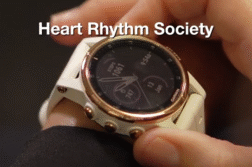SAN FRANCISCO. (Ivanhoe Newswire) — Atrial fibrillation is the most common heart rhythm ailment, affecting more than two million people in the U.S.
It’s an electrical problem that prevents the heart from pumping blood correctly. Doctors often treat it by ablating, or zapping, the trouble spot, but that doesn’t always work. Now a new technique is pinpointing the exact source of the problem and improving the treatment odds.
Sixty-six-year-old Bob Westlund couldn’t have done this a year and a half ago.
“When I’ve been in AFib, my energy levels are terrible,” detailed Westlund.
Sanjiv Narayan, M.D., a professor of medicine at Stanford Arrhythmia Center in San Francisco, California, used a new mapping technique on Westlund: focal impulse and rotor modulation, or FIRM. Atrial fibrillation appears to send out chaotic waves, but Dr. Narayan’s FIRM electrical mapping software shows there is actually a pattern, kind of like the eye of a hurricane.
Dr. Narayan and his team use FIRM mapping to zero in on the rotors, the centers of those spirals, which are sending out electrical waves, then zaps them with heat.
“What we have seen is if you take a standard PVI ablation procedure, often quoted as having a success rate of 50-60 percent, we can add 20 percent to that,” Dr. Narayan told Ivanhoe. (Read Full Interview)
Westlund, who’s a retired engineer, appreciates the cutting edge science, but mostly, he’s glad he feels well enough to garden and walk with his dog.
“Heart rate keeps up with me. It doesn’t accelerate madly,” said Westlund.
After decades of living with AFib, Westlund is optimistic it’s gone for good.
FIRM mapping does add about an hour to the ablation process and Dr. Narayan said the firm technique is not perfect. His team is still working on ways to improve the outcome.
Contributors to this news report include: Cyndy McGrath, Supervising Producer; Wendy Chioji, Field Producer; Milvionne Chery, Assistant Producer; Brent Sucher, Editor; Rusty Reed, Videographer.
MEDICAL BREAKTHROUGHS – RESEARCH SUMMARY
TOPIC: FIRM For A-Fib
REPORT: MB #4166
BACKGROUND: Ablation is commonly used for heart rhythm ailments, such as atrial fibrillation, or AFib, when long-term medications are not effective. Before the ablation surgery, an electrically sensitive catheter is used to map the heart muscle and the origins of the extra electrical activity throughout the heart. The map shows the physician which areas of the heart are creating problematic electric signals that interfere with the proper rhythm. A catheter is then inserted into the patient’s blood vessels and is guided to the heart. The physician carefully destroys the malfunctioning tissue using the catheter to scar the problematic areas and the scarred areas will no longer send abnormal signals. The heart will return to a normal rhythm if the procedure is successful. However, in some cases, AFib may return and the ablation procedure may need to be tried multiple times.
(Source: http://www.heart.org/HEARTORG/Conditions/Arrhythmia/AboutArrhythmia/Non-surgical-Procedures-for-Atrial-Fibrillation-AFib-or-AF_UCM_423782_Article.jsp#.V-0i6PkrIdU)
TYPES OF ABLATIONS: Common types of ablation for AFib include pulmonary vein isolation ablation (PVI) and AV node ablation with pacemakers. During the PVI procedure, the catheter tip is used to destroy the tissue that is sending the extra currents for patients whose AFib is triggered by extra electrical currents in the pulmonary veins. For some AFib patient, the trigger occurs in the AV node. In those cases an AV node ablation is used. During the procedure, the catheter is placed near the AV node and a small area of tissue is destroyed. Afterwards, a pacemaker is then implanted to restore and maintain the heart’s normal rhythm.
(Source: http://www.heart.org/HEARTORG/Conditions/Arrhythmia/AboutArrhythmia/Non-surgical-Procedures-for-Atrial-Fibrillation-AFib-or-AF_UCM_423782_Article.jsp#.V-0i6PkrIdU)
NEW TECHNOLOGY: Focal Impulse and Rotor Modulation, or FIRM, is a new type of ablation technique used to treat patients with atrial fibrillation. FIRM ablation allows doctors to find the exact electrical source that causes atrial fibrillation much faster than other ablation methods. FIRM mapping combined with the ablation procedure takes about 90 minutes. It may take longer if combined with (PVI). FIRM ablation destroys less atrial tissue than traditional ablation and improves the success rate of PVI by 20%-40%. In 2013, the FDA approved the mapping catheter used in FIRM ablation and in a 2011 study, a clinical trial of 107 patients showed that two years after treatment, 86% of those treated with FIRM ablation had not had a recurrence of atrial fibrillation, compared to 44.9% of those who received traditional therapy.
(Source: https://stanfordhealthcare.org/medical-treatments/f/firm-ablation.html)
FOR MORE INFORMATION ON THIS REPORT, PLEASE CONTACT:
Angela Tsiperfal, MS, RN, ACNP-BC, CNS, CCDC
Lead Nurse Practitioner, Stanford Arrhythmia Service
650-723-7111
atsiperfal@stanfordhealthcare.org
If this story or any other Ivanhoe story has impacted your life or prompted you or someone you know to seek or change treatments, please let us know by contacting Marjorie Bekaert Thomas at mthomas@ivanhoe.com




